SaaS Annual Report 2023-2024: Key Insights and Trends
SaaS Annual Report 2023-2024 Notes
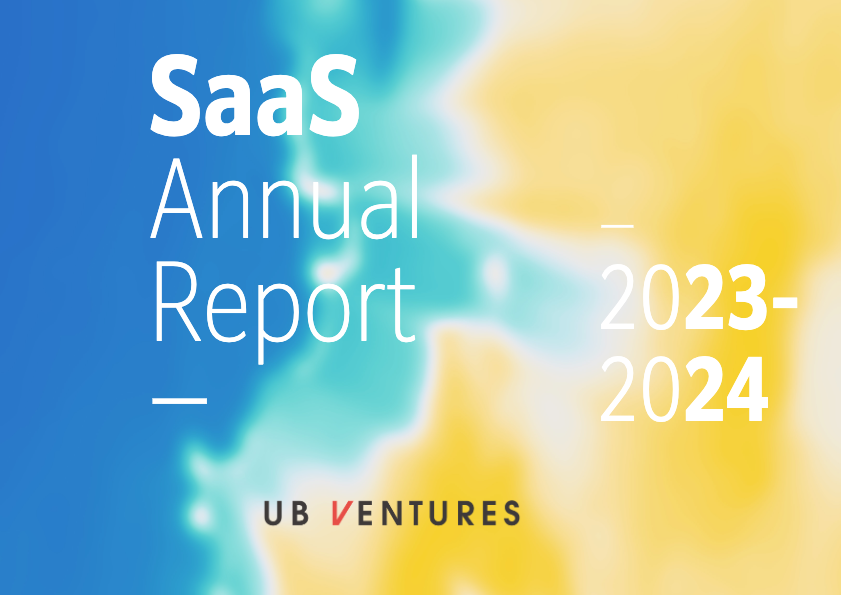
Overview
- Title: SaaS Annual Report
- Period: 2023-2024
- Publisher: UB Ventures
Key Points
SaaS Industry Insights
- Definition: SaaS stands for Software as a Service, a model where software is delivered via the internet rather than installed locally.
- Trend Analysis: The SaaS model continues to grow due to its scalability and flexibility. Cloud-based services are increasingly preferred for their cost-effectiveness and ease of integration.
Annual Performance
- Growth Metrics: The report likely covers key performance indicators (KPIs) such as revenue growth, customer acquisition, and retention rates.
- Market Trends: Understanding market demands and emerging technologies that influence the SaaS landscape is crucial for this period.
Strategic Initiatives
- Innovation Focus: How the company plans to innovate in terms of product features, customer experience, and technology advancements.
- Partnerships and Collaborations: Potential collaborations with other firms or industries that could enhance business offerings.
Visuals and Design
- Color Scheme: The report uses a blend of blue and yellow, potentially reflecting stability and optimism for the year ahead.
Additional Insights
- UB Ventures: As the publisher, this entity may play a crucial role in investing and driving growth in the SaaS sector.
- Annual Reporting Importance: These reports are crucial for stakeholders to understand the direction, strategies, and financial health of a company.
This set of notes is aimed at providing a comprehensive understanding of the SaaS Annual Report by UB Ventures for the year 2023-2024, emphasizing key industry trends, growth metrics, and strategic directions.
Extended readings:
SaaS and a Depopulating Society
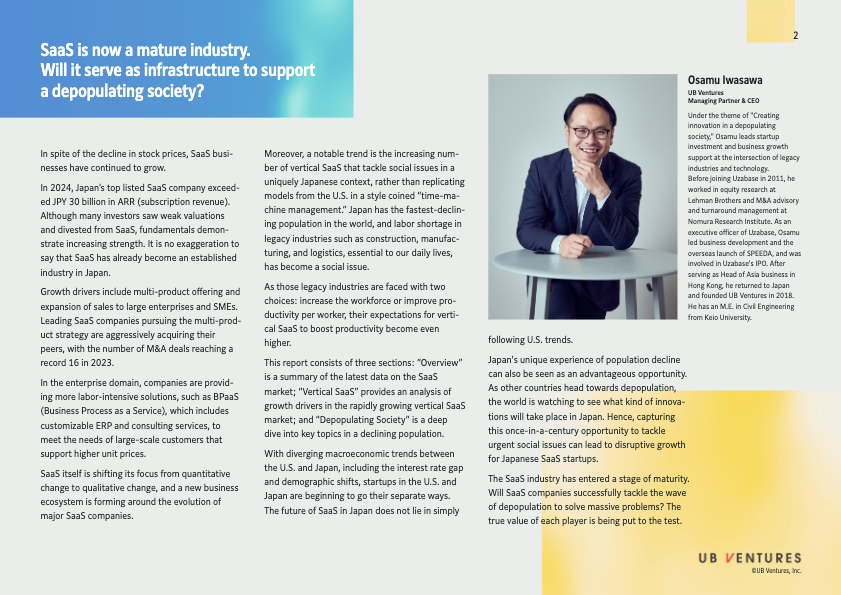
Industry Growth and Maturity
-
Continuous Growth:
- Despite a decline in stock prices, SaaS businesses in Japan continue to grow.
- In 2024, the top listed SaaS companies in Japan exceeded JPY 30 billion in ARR (Annual Recurring Revenue).
- Insights: The growth indicates the resilience and establishment of SaaS as a key industry in Japan.
-
Growth Drivers:
- Includes multi-product offerings and expanding sales to large enterprises and SMEs.
- M&A (Mergers and Acquisitions) deals reached a record 16 in 2023.
- Insights: Diversification and strategic acquisitions are essential for scaling and maintaining competitive advantage.
Emerging Trends
-
Vertical SaaS Solutions:
- Increase in vertical SaaS addressing social issues specific to Japan, unlike the U.S. models.
- Known as "time-machine management," focusing on sectors like construction, manufacturing, and logistics.
- Insights: Customization to meet local social needs can offer competitive advantages and innovative solutions.
-
Depopulation Challenges:
- Japan faces the fastest declining population.
- Labor shortages are significant in legacy industries.
- Legacy industries must choose between increasing workforce or enhancing productivity.
- Insights: SaaS can play a crucial role in improving productivity, mitigating labor shortages.
Economic and Social Context
-
Macroeconomic Divergence:
- Differences in macroeconomic trends between the U.S. and Japan, such as interest rate gaps and demographic shifts.
- Startups in Japan are diverging from U.S. trends, creating unique solutions.
- Insights: Understanding local context and creating tailored solutions is crucial for SaaS businesses in Japan.
-
Opportunities in Decline:
- Population decline seen as an opportunity for innovation.
- Potential for disruptive growth by addressing local issues through SaaS.
- Insights: Turning demographic challenges into business opportunities can lead to groundbreaking innovations.
Leadership
- Osamu Iwasawa's Vision:
- Leading UB Ventures with a focus on "Creating innovation in a depopulating society."
- Background in equity research, M&A, and business development.
- Insights: Leadership with deep market understanding and experience in strategic growth is vital for navigating industry changes.
Future Outlook
- SaaS as Infrastructure:
- The SaaS industry is maturing, posing the question of its role in supporting a depopulating society.
- True value of each player in the market is increasingly tested.
- Insights: As the industry matures, companies must innovate and adapt to sustain and grow amidst demographic shifts.
Extended readings:
SaaS Companies in Japan: ARR Overview
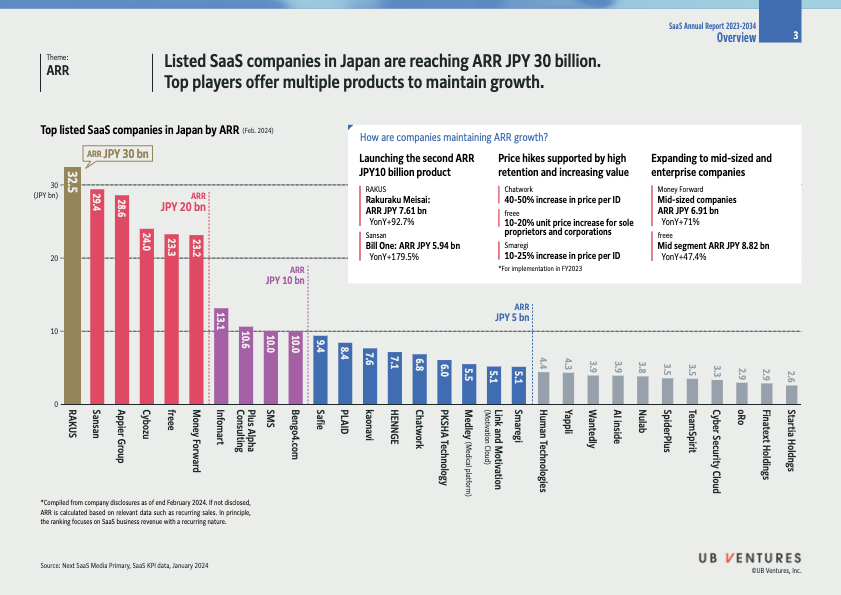
Key Insights
- Annual Recurring Revenue (ARR):
- ARR is a crucial metric indicating the predictable revenue stream from SaaS products, essential for assessing growth and sustainability.
Top SaaS Companies in Japan by ARR (February 2024)
| Company | ARR (JPY bn) |
|---|---|
| RAKUS | 32.5 |
| Sansan | 29.4 |
| Appier Group | 28.6 |
| Cybozu | 24.0 |
| freee | 23.3 |
| Money Forward | 23.2 |
| Plus Alpha Consulting | 13.1 |
| SMS | 10.6 |
| Bengo4.com | 10.0 |
| Chatwork | 10.0 |
| PLAID | 9.4 |
| kaonavi | 8.4 |
| HENNGE | 7.6 |
| PKSHA Technology | 6.0 |
| Medley (Medical) | 5.5 |
Strategies for Maintaining ARR Growth
1. Launching Additional High-Revenue Products
- RAKUS: Rakuraku Meisai brings an ARR of JPY 7.61 bn with 92.7% year-on-year (YoY) growth.
- Sansan: Bill One contributes JPY 5.94 bn ARR, marking YoY growth of 179.5%.
2. Price Increases Backed by High Retention
- Chatwork: Implemented a 40-50% price increase per ID.
- freee: Achieved a 10-20% unit price increase for both sole proprietors and corporations.
- Smaregi: Prices per ID increased by 10-25%.
3. Expansion into Mid-sized and Enterprise Markets
- Money Forward: Mid-sized companies ARR reaches JPY 6.91 bn, with a 71% YoY increase.
- freee: Mid-segment ARR stands at JPY 8.82 bn, showing 47.4% YoY growth.
Additional Notes
- Importance of ARR: This metric helps businesses evaluate their recurring revenue, ensuring financial health and aiding strategic decision-making.
- YoY Growth: Indicates how companies are increasing their annual revenues each year, reflecting successful strategies and market expansion.
Extended readings:
Product Portfolios of Top Listed SaaS Companies in Japan
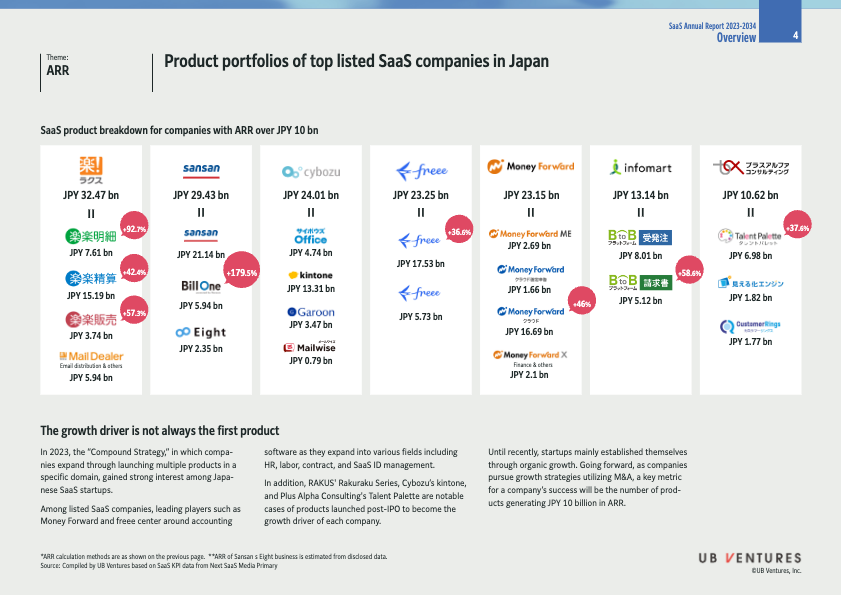
Overview
SaaS Companies and ARR
The overview focuses on the Annual Recurring Revenue (ARR) of leading SaaS companies in Japan, highlighting those with ARR exceeding JPY 10 billion. The data is compiled by UB Ventures based on SaaS KPI data from Next SaaS Media.
Key Companies and Their ARR
| Company & Product | ARR (JPY bn) | Growth Percentage |
|---|---|---|
| Sansan | 29.43 | +179.5% |
| Cybozu | 24.01 | - |
| freee | 23.25 | +36.6% |
| Money Forward | 23.15 | - |
| infomart | 13.14 | +46% |
| フジクラ | 10.62 | +37.6% |
Growth Drivers
-
Compound Strategy: This strategy involves expanding through multiple products within a specific domain. It has gained traction among Japanese SaaS startups as it allows diversification and deeper market penetration.
-
Key Players: Companies like Money Forward and freee have established accounting software at their core while expanding into other fields such as HR, labor, contract, and SaaS ID management.
-
Post-IPO Growth: Products introduced post-IPO have become significant growth drivers. Examples include RAKUS' Rakuraku Series, Cybozu’s kintone, and Plus Alpha Consulting's Talent Palette.
Insights and Trends
-
Organic Growth: Traditionally, startups focused on organic growth. However, there's a shift towards using mergers and acquisitions (M&A) as part of their growth strategies.
-
Success Metrics: The number of products generating JPY 10 billion in ARR is becoming a critical success metric for companies.
Additional Information
-
ARR: This is a key metric used to assess the financial health and revenue stability of SaaS companies. Understanding ARR growth can indicate the scalability and market acceptance of a company's products.
-
Diversification: Expanding into multiple product categories helps mitigate risk and capture a larger customer base, which is a common strategy among successful SaaS companies.
Extended readings:
SaaS Annual Report 2023-2024 Overview

Valuation Insights
Average PSR Trends
- PSR Stability: The average Price to Sales Ratio (PSR) has remained between 6-8x since 2022.
- Insight: Investors may view this stability as indicating a mature market for certain SaaS companies. The consistent PSR helps in forecasting and making informed investment decisions.
Rule of 40%
- Definition: The Rule of 40% refers to the combined annual recurring revenue (ARR) growth rate and profit margin exceeding 40%.
- Explanation: This rule is a benchmark for gauging the balance between growth and profitability in SaaS companies. Companies that meet this rule are often seen as healthier investments.
Valuation and Growth
- High Growth is Not Enough: In 2023, companies with mere high growth but without profitability, like freee, saw a decline in valuation.
- Insight: The market is rewarding companies like RAKUS and eWeLL that balance profitability with growth, reflecting a shift in investor priorities.
Average PSR Comparison (End Feb. 2024)
- Achieved Rule of 40%:
- 11 Companies: 7.1x PSR
- Unachieved Rule of 40%:
- 17 Companies: 5.3x PSR
- Insight: Meeting the Rule of 40% increases a company's PSR, indicating higher investor trust and perceived value.
Historical PSR Analysis
- Graph Analysis:
- Displays the PSR trends for companies like freee and RAKUS from 2021 to 2024.
- Key Observations: A spike in valuation can be associated with favorable financial performance and market conditions.
Conclusion
- Profitability Focus: Profit became a significant valuation factor in 2023, emphasizing the market’s preference for SaaS companies achieving a balance between expansion and sustainable earnings.
Extended readings:
SaaS Annual Report 2023-2034 Overview
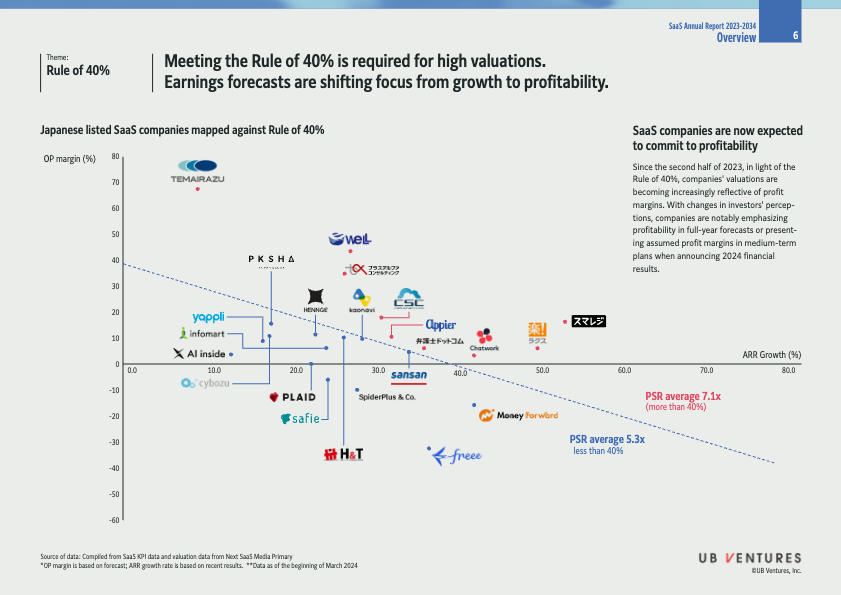
Key Theme: Rule of 40%
Understanding the Rule of 40%
- Rule of 40% : A metric used to evaluate the performance of SaaS companies. It is the sum of a company's growth rate and profitability (operating profit margin). A combined total above 40% is considered strong.
- Insight: Investors often use this rule to balance growth and profitability, ensuring companies are not sacrificing long-term profit for immediate growth.
Current Trends in SaaS Companies
- Shift in Focus: Earnings forecasts are increasingly shifting from growth to profitability.
- Insight: This shift reflects changes in investor expectations, where profitability is now a significant factor in company valuations.
Profitability Expectations
- SaaS companies are now expected to commit to profitability.
- Companies are emphasizing profitability in full-year forecasts or through medium-term plans for 2024 financial results.
Market Data Insights
- Data Source: Compiled from SaaS KPI data and valuation data from Next SaaS Media Primary.
- Forecast Basis: OP margin is based on forecasts, while ARR growth rate relies on recent results, with data as of early March 2024.
Valuation Implications
- PSR (Price-to-Sales Ratio) Averages:
- Companies meeting the Rule of 40% often have a higher PSR (average 7.1x).
- Those below the 40% threshold have a lower PSR (average 5.3x).
- Insight: This suggests a correlation between meeting the rule and achieving higher valuations.
Visual Representation
- A graph is used to map Japanese listed SaaS companies against the Rule of 40%, comparing OP margin (%) and ARR Growth (%).
- ARR (Annual Recurring Revenue) : A crucial metric for assessing a SaaS company’s performance, representing stable revenue that can be expected annually.
Contextual Understanding
- Investor Perceptions: There is an evolution in how investors perceive company value, with a stronger emphasis on long-term profitability.
- Strategic Planning: Companies might need to adjust strategic plans to align growth ambitions with profitability goals more closely.
Additional Context
- The information is relevant as of the beginning of March 2024 and reflects ongoing market trends and investment strategies.
This report highlights the importance of balancing growth and profitability for SaaS companies to meet investor expectations and sustain high valuations.
Extended readings:
SaaS IPO Market Overview 2023-2024
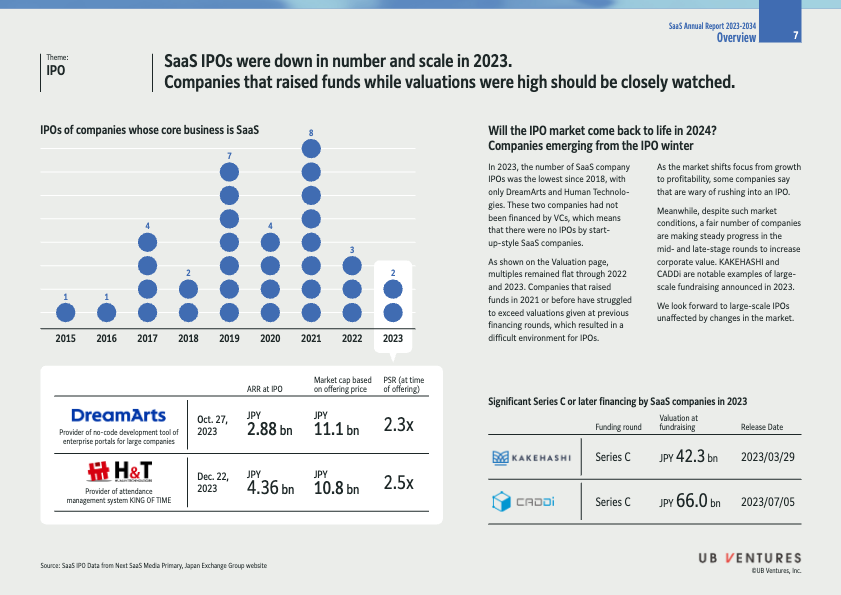
Key Insights
-
Decline in SaaS IPOs:
- In 2023, the number of SaaS IPOs was the lowest since 2018, with only two companies going public: DreamArts and Human Technologies.
- These companies were not funded by venture capitalists (VCs), indicating a challenge for startup-style SaaS firms to go public.
-
Market Shift:
- The industry focus is shifting from rapid growth to profitability, making companies cautious about early IPOs.
- Companies that raised funds in 2021 or earlier find it challenging to surpass valuations from previous funding rounds.
-
Future Outlook:
- Optimism exists for a resurgence of larger IPOs in 2024, unaffected by these market challenges.
Data Summary
IPOs of SaaS Companies (2015-2023)
| Year | Number of IPOs |
|---|---|
| 2015 | 1 |
| 2016 | 1 |
| 2017 | 4 |
| 2018 | 2 |
| 2019 | 7 |
| 2020 | 8 |
| 2021 | 4 |
| 2022 | 3 |
| 2023 | 2 |
Recent IPOs
DreamArts
- Date: October 27, 2023
- ARR at IPO: JPY 2.88 bn
- Market Cap: JPY 11.1 bn
- PSR (Price-to-Sales Ratio) : 2.3x
- Description: Provides no-code development tools for enterprise portals.
Human Technologies
- Date: December 22, 2023
- ARR at IPO: JPY 4.36 bn
- Market Cap: JPY 10.8 bn
- PSR: 2.5x
- Description: Offers the attendance management system "King of Time".
Significant Series C or Later Fundraising in 2023
| Company | Funding Round | Valuation | Release Date |
|---|---|---|---|
| KAKEHASHI | Series C | JPY 42.3 bn | 2023/03/29 |
| CADDi | Series C | JPY 66.0 bn | 2023/07/05 |
Analysis
- Investment Climate: The environment is challenging for newcomers aiming to achieve IPOs without prior VC support, highlighting the importance of profitability and sustainable growth.
- Strategic Consideration: Companies are increasingly focusing on enhancing corporate value through strategic fundraisers instead of rushing into IPOs under unfavorable conditions.
Extended readings:
2023 SaaS M&A Overview
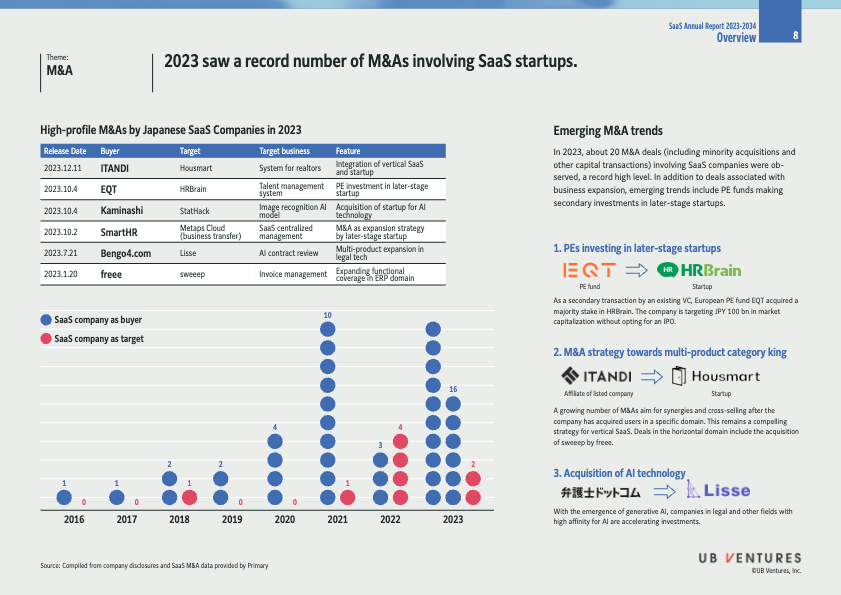
High-profile M&A Deals in 2023
Key M&A Transactions by Japanese SaaS Companies
| Release Date | Buyer | Target | Target Business | Feature |
|---|---|---|---|---|
| 2023.12.11 | ITANDI | Housmart | System for realtors | Integration of vertical SaaS and startup |
| 2023.10.4 | EQT | HRBrain | Talent management system | PE investment in later-stage startup |
| 2023.10.4 | Kaminashi | StatHack | Image recognition AI model | Acquisition of startup for AI technology |
| 2023.10.2 | SmartHR | Metaps Cloud (business transfer) | SaaS centralized management | M&A as expansion strategy by later-stage startup |
| 2023.7.21 | Bengo4.com | Lisse | AI contract review | Multi-product expansion in legal tech |
| 2023.1.20 | freee | sweeep | Invoice management | Expanding functional coverage in ERP domain |
Insights
-
Integration of Vertical SaaS: ITANDI's acquisition of Housmart exemplifies the integration strategies for vertical SaaS platforms, focusing on niche markets such as real estate systems.
-
PE Investments in Later-stage Startups: EQT's investment in HRBrain reflects the growing trend of private equity funds targeting later-stage startups for substantial returns without pursuing IPOs.
-
AI Technology Acquisitions: With the increasing relevance of AI, companies like Kaminashi are acquiring startups like StatHack to leverage AI in their offerings.
M&A Trends in 2023
Key Trends
-
PE Investments in Later-stage Startups:
- PE funds, such as EQT, are acquiring significant stakes in established startups, focusing on enlarging market cap without IPOs.
- Insight: This reflects a strategic focus on long-term growth and market positioning rather than short-term exit strategies.
-
Multi-product Expansion:
- Acquisitions, like freee acquiring sweeep, aim for synergies and cross-selling opportunities, enhancing SaaS companies' value propositions.
- Insight: Vertical SaaS companies are diversifying product lines to become category leaders.
-
AI Technology Acquisition:
- The demand for AI-driven solutions is driving companies to invest in AI technologies, highlighted by Bengo4.com's acquisition of Lisse.
- Insight: Legal tech and other sectors are actively seeking AI integrations to enhance service offerings.
M&A Activity (2016-2023)
- The graph indicates a significant increase in M&A activity, peaking in 2023, highlighting the dynamic growth and interest in SaaS companies.
Conclusion
- Record High M&As: 2023 observed approximately 20 M&A deals involving SaaS companies, showcasing increasing interest and strategic alignments in technological advancements and market expansions within the SaaS sector.
Extended readings:
Japanese SaaS Startup Fundraising Overview 2023
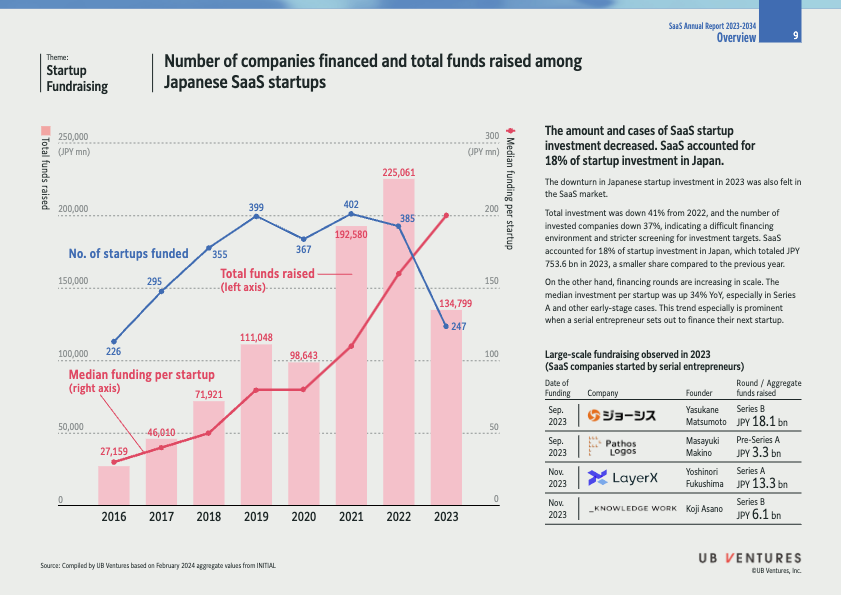
Key Highlights
-
Decrease in Investment:
- Total investment in Japanese SaaS startups decreased by 41% from 2022.
- The number of funded companies dropped by 37%.
Insight: This indicates a challenging funding environment, likely due to economic uncertainties or stricter investment criteria.
-
Share of Total Investment:
- SaaS accounted for 18% of Japan's startup investments in 2023.
- Total startup investment was JPY 753.6 billion.
Insight: Despite the drop, SaaS maintained a significant share, showing its importance in the startup ecosystem.
Funding Trends
-
Median Funding Increase:
- Median funding per startup rose by 34% year-over-year.
- Notably increased primarily in Series A and early-stage investments.
Insight: Indicates a focus on larger, more substantial investments for potential high-growth startups, often led by experienced entrepreneurs.
Large-scale Fundraising by Serial Entrepreneurs
| Date | Company | Founder | Round/ Aggregate Funds (JPY) |
|---|---|---|---|
| Sep. 2023 | - | Yasukane Matsumoto | Series B / 18.1 bn |
| Sep. 2023 | - | Masayuki Makino | Pre-Series A / 3.3 bn |
| Nov. 2023 | - | Yoshinori Fukushima | Series A / 13.3 bn |
| Nov. 2023 | - | Koji Asano | Series B / 6.1 bn |
Insight: Serial entrepreneurs are key players, often securing significant funding rounds, highlighting investor confidence in their experience and vision.
Funding and Investment Trends (2016-2023)
-
No. of Startups Funded:
- Peaked at 402 in 2021 and dropped to 247 in 2023.
-
Total Funds Raised:
- Peaked at JPY 225,061 million in 2022, declining to JPY 134,799 million in 2023.
-
Median Funding Per Startup:
- Increased from JPY 27,159 million in 2016 to JPY 71,921 million in 2023.
Insight: While the number of startups and total funds have declined recently, individual funding levels are rising, indicating selective and focused investment strategies.
Conclusion
The landscape for SaaS startups in Japan is marked by reduced overall investment, but increased funding per company. This trend reflects a preference for targeted, impactful investments, especially favoring experienced entrepreneurial leadership.
Extended readings:
ARR Acquisition Efficiency Notes
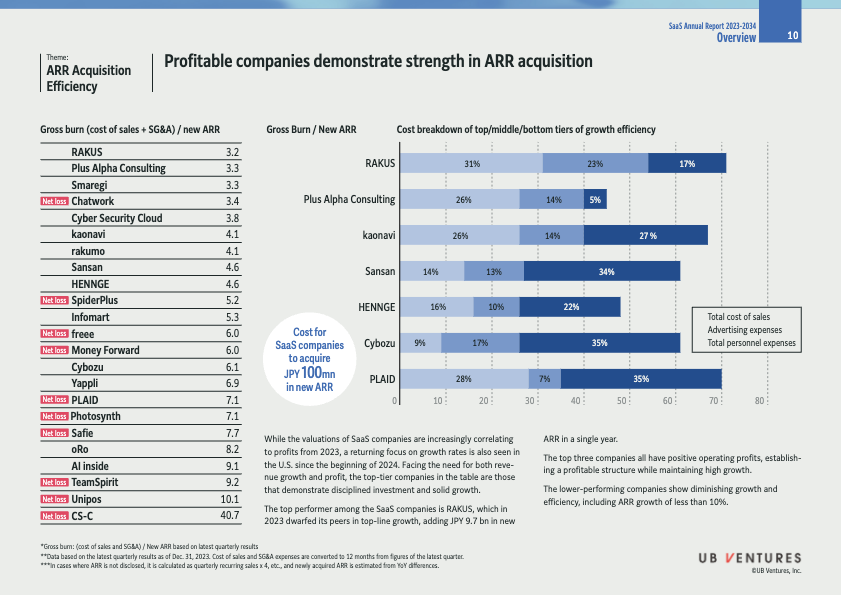
Overview
This section of the SaaS Annual Report 2023-2024 focuses on the efficiency of acquiring Annual Recurring Revenue (ARR) by analyzing costs and growth rates.
Key Concepts
- Gross Burn: Calculated as the cost of sales plus SG&A (Selling, General, and Administrative expenses) divided by new ARR. It reflects the expenditure incurred to acquire new revenue.
Gross Burn / New ARR
-
Top Performers:
- RAKUS: 3.2
- Plus Alpha Consulting: 3.3
- Smaregi: 3.3
-
Moderate Performers:
- Chatwork: 3.4
- Cyber Security Cloud: 3.8
- kaonavi and rakumo: 4.1
-
Lower Performers (with Net Loss) :
- SpiderPlus: 5.2
- Infomart: 5.3
- freee and Money Forward: 6.0
- CS-C (Significant Loss) : 40.7
Cost Breakdown of Growth Efficiency
The cost is divided into:
- Total Cost of Sales
- Advertising Expenses
- Total Personnel Expenses
Examples:
- RAKUS: 31% cost of sales, 23% advertising, 17% personnel
- Sansan: 14% cost of sales, 13% advertising, 34% personnel
Insights
- Profitable Companies: Demonstrate the ability to balance growth and profits with efficient cost structures. Top companies maintain positive operating profits and high growth rates.
- Investment & Growth Discipline: Companies like RAKUS show disciplined investment strategies leading to strong top-line growth.
- Market Trends: SaaS valuations are increasingly linked to profits, with a renewed focus on growth in the U.S. in 2024.
Conclusion
Efficient ARR acquisition is crucial for profitability and growth, with the top companies in this analysis showing a strategic balance of investment and expense management to maintain strong performance.
Top Vertical SaaS Startups in Japan by Valuation
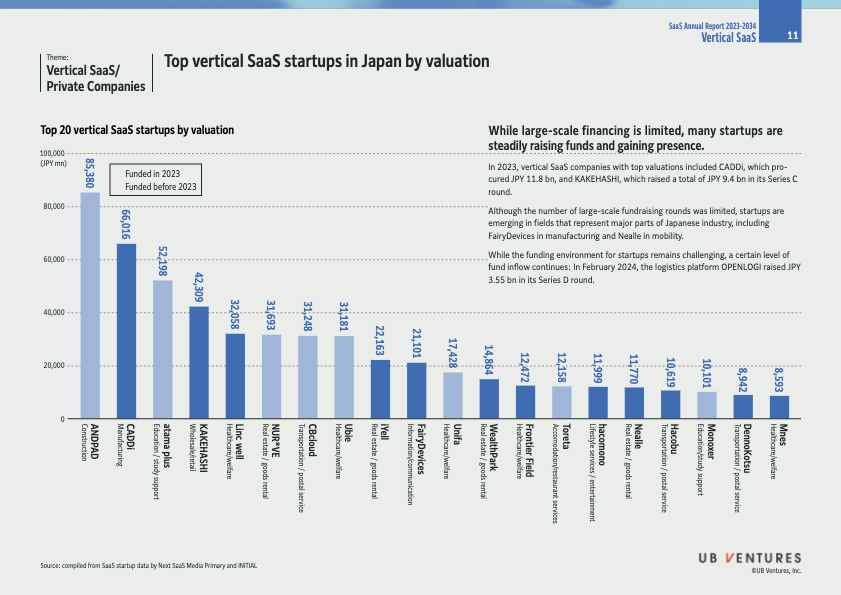
Overview
This report provides an analysis of the top 20 vertical SaaS startups in Japan, ranked by valuation. Vertical SaaS refers to software solutions tailored for specific industries, supporting niche markets with specialized functionalities.
Key Highlights
- Limited Large-Scale Financing:
- While large-scale fundraising is limited in Japan, several startups are steadily gaining financial support and increasing their market presence.
- Notable fundraising in 2023 includes CADDi and KAKEHASHI, securing significant investments.
Top 20 Vertical SaaS Startups by Valuation
| Company | Industry | Valuation (JPY mn) | Funding Year |
|---|---|---|---|
| ANDPAD | Construction | 85,380 | Funded before 2023 |
| CADDi | Manufacturing | 66,016 | Funded before 2023 |
| atama plus | Education/study support | 52,198 | Funded before 2023 |
| KAKEHASHI | Wholesale/retail | 42,309 | Funded in 2023 |
| Linc well | Healthcare/welfare | 32,058 | Funded before 2023 |
| NUR*VE | Real estate/goods rental | 31,693 | Funded before 2023 |
| CBcloud | Transportation/postal service | 31,248 | Funded before 2023 |
| Ubie | Healthcare/welfare | 31,181 | Funded before 2023 |
| iYell | Real estate/goods rental | 22,163 | Funded before 2023 |
| FairyDevices | Information/communication | 21,101 | Funded before 2023 |
| Unifa | Healthcare/welfare | 17,428 | Funded before 2023 |
| WealthPark | Real estate/goods rental | 14,864 | Funded before 2023 |
| Frontier Field | Healthcare/welfare | 12,472 | Funded before 2023 |
| Toreta | Accommodation/restaurant | 12,158 | Funded before 2023 |
| hacomono | Lifestyle services/entertainment | 11,999 | Funded before 2023 |
| Nealle | Real estate/goods rental | 11,770 | Funded before 2023 |
| Hacobu | Transportation/postal service | 10,619 | Funded before 2023 |
| Monoxer | Education/study support | 10,101 | Funded before 2023 |
| DennoKotsu | Transportation/postal service | 8,942 | Funded before 2023 |
| Mnes | Healthcare/welfare | 8,593 | Funded before 2023 |
Insights
-
Dominant Industries:
- Startups in healthcare, real estate, and transportation are prominently represented in this list.
- These industries address key societal needs and leverage technology for enhanced service delivery.
-
Emerging Fields:
- Companies like FairyDevices and Nealle are emerging in critical sectors such as manufacturing and mobility, reflecting the evolving industrial landscape in Japan.
-
Funding Challenges:
- Despite challenging funding environments, startups like OPENLOGI continue to attract investment. This indicates ongoing interest and potential for growth within these verticals.
Conclusion
Japanese vertical SaaS startups are gaining traction in diverse industries, with some achieving high valuations. While large-scale financing rounds are limited, strategic investments continue to support growth and innovation in this sector.
Extended readings:
Vertical SaaS Investment Insights
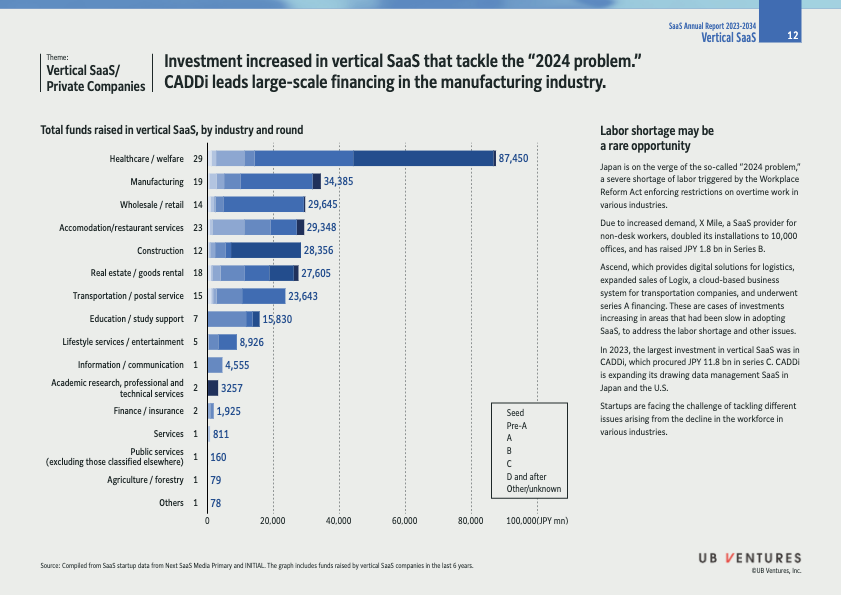
Overview
Labor Shortage as an Opportunity
- 2024 Problem: Japan is facing a severe labor shortage due to the Workplace Reform Act, which enforces overtime restrictions.
- Investment Surge: This labor issue is creating opportunities for SaaS solutions to fill the gaps.
Notable Companies and Investments
- X Mile: A SaaS provider for non-desk workers expanded to 10,000 locations, securing JPY 1.8 billion in Series B.
- Ascend: Focused on logistics, expanded its cloud-based business system, Logix, and completed Series A financing.
CADDi's Lead
- Major Investment: CADDi procured JPY 11.8 billion in Series C to expand its data management SaaS in Japan and the U.S.
Fundraising Data
| Industry | Number of Rounds | Total Funds Raised (JPY mn) |
|---|---|---|
| Healthcare / welfare | 29 | 87,450 |
| Manufacturing | 19 | 34,385 |
| Wholesale / retail | 14 | 29,645 |
| Accommodation/restaurant services | 23 | 29,348 |
| Construction | 12 | 28,356 |
| Real estate / goods rental | 18 | 27,605 |
| Transportation / postal service | 15 | 23,643 |
| Education / study support | 7 | 15,830 |
| Lifestyle services / entertainment | 5 | 8,926 |
| Information / communication | 1 | 4,555 |
| Academic research, professional services | 2 | 3,257 |
| Finance / insurance | 2 | 1,925 |
| Services | 1 | 811 |
| Public services | 1 | 160 |
| Agriculture / forestry | 1 | 79 |
| Others | 1 | 78 |
Insights
- Healthcare and Welfare: Attracts the highest investment, reflecting the demand for digital health solutions amid aging populations and healthcare reforms.
- Manufacturing: Significant investments highlight the push for automation and smart factory solutions.
- Diverse Categories: Funding spread across traditional and emerging industries shows SaaS’s broad applicability in addressing specific challenges.
Conclusion
- Startups targeting specific industrial challenges with vertical SaaS solutions are seeing increased investments.
- Addressing labor shortages and regulatory changes presents a lucrative opportunity for technology providers.
Extended readings:
Innovation in a Depopulating Society
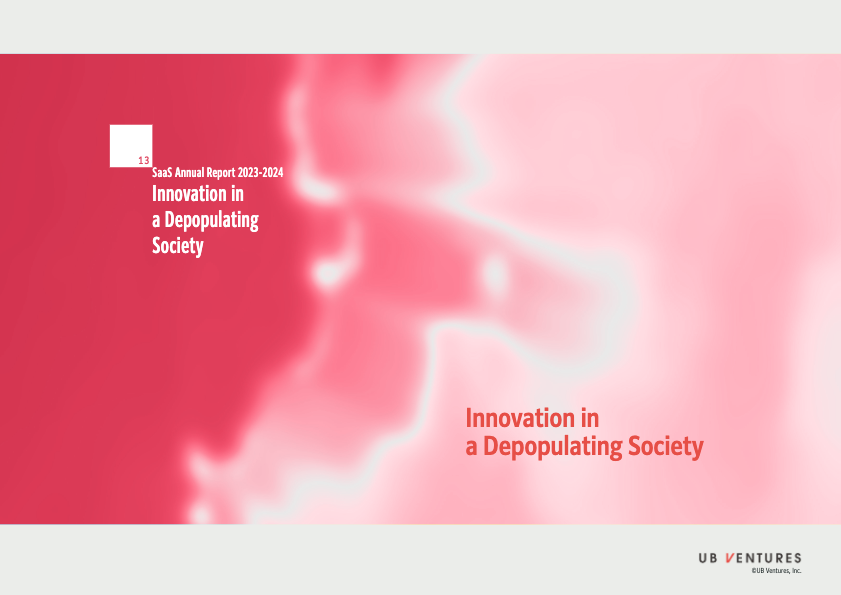
Overview
- Theme: Innovation in a Depopulating Society
- Context: This concept explores how societies facing population decline can leverage innovation to maintain and improve living standards.
Key Insights
-
Depopulation Challenges:
- Economic Impact: Shrinking labor force, reduced economic output.
- Social Impact: Aging population, increased healthcare needs.
- Infrastructure: Declining demand for infrastructure can lead to excess capacity.
-
Opportunities for Innovation:
- Automation and AI: Implementing technologies to compensate for reduced human workforce.
- Smart Infrastructure: Designing adaptable infrastructure that scales with population.
- Healthcare Technology: Innovations in telemedicine and home care for aging populations.
-
Strategic Approaches:
- Policy Adjustments: Implement policies that attract talent and retain population.
- Sustainable Development: Focus on sustainable practices to ensure resource efficiency.
Conclusion
Societies experiencing depopulation can harness technology and innovative practices to address the challenges arising from reduced populations. By focusing on smart, adaptable solutions, these societies can sustain their economic and social systems effectively.
Extended readings:
Japan's Workforce Decline and GDP Growth
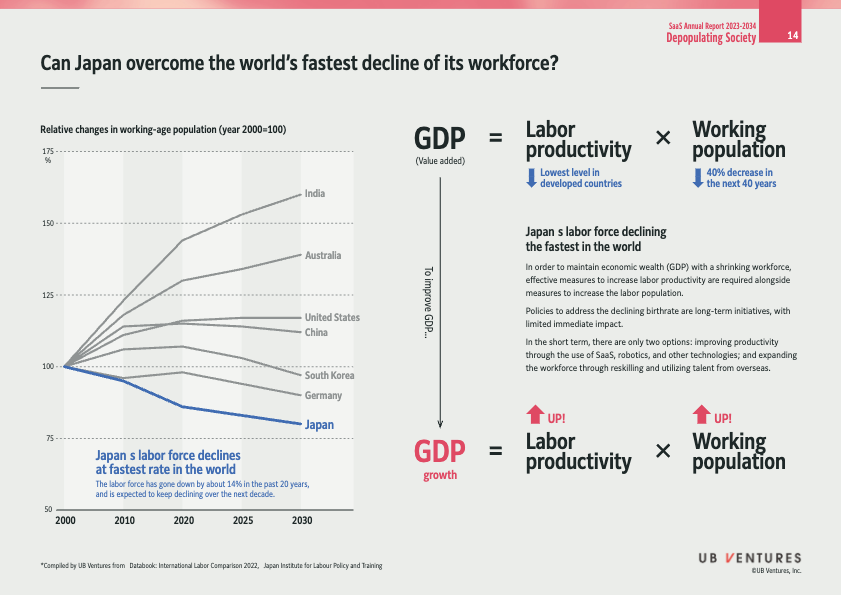
Overview
Japan faces the world's fastest decline in its working-age population, impacting its GDP growth. This decline necessitates strategic measures to address labor productivity and workforce size.
Relative Changes in Working-Age Population (2000-2030)
-
Japan:
- Decline of around 14% over the past 20 years.
- Expected further decline over the next decade.
- Insight: With the lowest growth compared to other countries, Japan needs innovative strategies to counteract these trends.
-
Other Countries (Indexed to 2000=100):
- India: Significant growth toward 175%.
- Australia, United States, China, South Korea, Germany: Moderate growth.
- Insight: Japan is unique among developed nations, facing a steep decline, which requires targeted economic policies.
Key Challenges and Solutions
GDP Equation
- GDP (Value added) = Labor Productivity x Working Population
Challenges
-
Low Labor Productivity:
- Among the lowest in developed countries.
- Insight: Enhancing productivity is crucial, especially through technology.
-
Decreasing Working Population:
- Projected 40% decrease in the next 40 years.
- Insight: A shrinking workforce necessitates both productivity improvements and workforce expansion.
Solutions
- Improving Productivity:
- Utilize SaaS, robotics, and advanced technologies.
- Insight: Technological adoption can offset productivity losses due to a diminishing labor force.
- Expanding Workforce:
- Reskill existing workers.
- Utilize international talent.
- Insight: Diversifying and upskilling the workforce can fill labor gaps.
Policy Recommendations
-
Long-Term Initiatives:
- Address the declining birthrate.
- Limitation: Limited immediate impact but crucial for future sustainability.
-
Short-Term Focus:
- Prioritize technological integration and workforce diversification to stabilize GDP growth.
By implementing these strategies effectively, Japan can mitigate the economic impacts of its declining workforce and leverage new opportunities for growth.
Extended readings:
Eight Key Themes to Tackle Population Decline
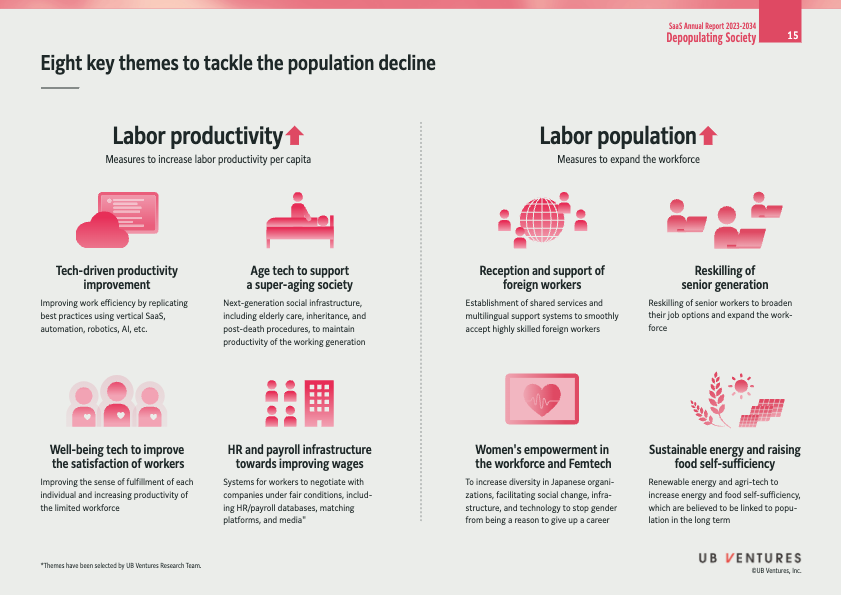
Labor Productivity
Measures to Increase Labor Productivity per Capita
-
Tech-Driven Productivity Improvement
- Uses vertical SaaS, automation, robotics, and AI to improve efficiency.
- Insight: These technologies can streamline processes, reduce errors, and enable workers to focus on more strategic tasks.
-
Age Tech to Support a Super-Aging Society
- Develops social infrastructure for elderly care, inheritance, and post-death processes.
- Insight: Ensuring support systems for aging populations can help maintain economic productivity and reduce burdens on the workforce.
-
Well-Being Tech to Improve the Satisfaction of Workers
- Aims to enhance individuals' fulfillment and productivity.
- Insight: A fulfilled workforce is typically more engaged and productive, reducing turnover and increasing company performance.
-
HR and Payroll Infrastructure Towards Improving Wages
- Provides systems for fair negotiation and conditions.
- Insight: Transparent HR systems can lead to better employee-management relations and fairer compensation.
Labor Population
Measures to Expand the Workforce
-
Reception and Support of Foreign Workers
- Establishes shared services and multilingual systems to integrate foreign workers.
- Insight: Welcoming skilled foreign workers can fill labor gaps and bring diverse perspectives and innovations.
-
Reskilling of Senior Generation
- Broadens job options for senior workers to expand the workforce.
- Insight: Reskilling can tap into the potential of experienced workers, offering new career pathways and extending their employability.
-
Women's Empowerment in the Workforce and Femtech
- Increases diversity by removing gender barriers in Japanese organizations.
- Insight: Encouraging gender equality in the workplace can lead to a more comprehensive and balanced workforce.
-
Sustainable Energy and Raising Food Self-Sufficiency
- Invests in renewable energy and agri-tech to enhance self-sufficiency.
- Insight: Sustainable practices support long-term economic stability and can mitigate risks associated with dependency on external resources.
The themes reflect strategies to mitigate the challenges of a declining population, focusing on enhancing productivity and expanding the workforce through various innovative and inclusive measures.
Extended readings:
Vertical SaaS in Regional Economies: Barriers and Solutions
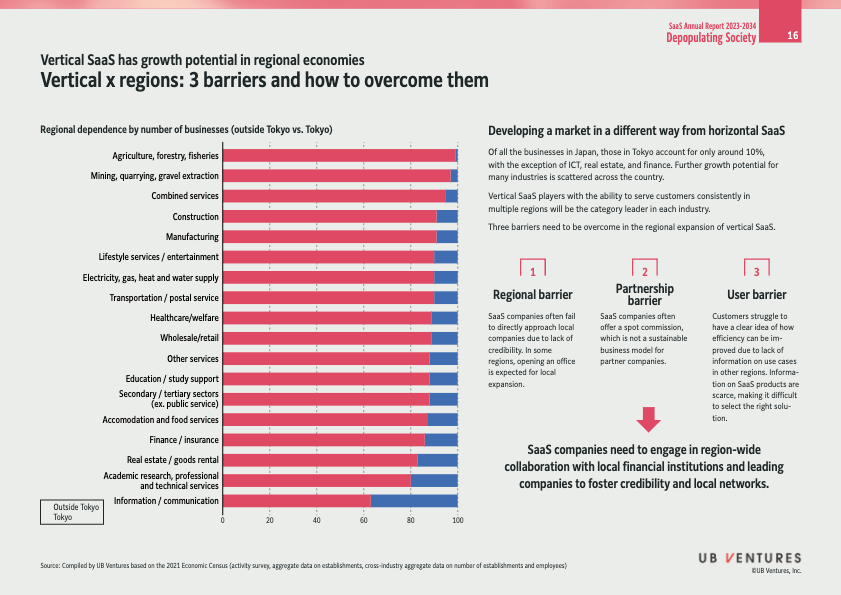
Overview
Vertical SaaS has significant growth potential in Japan's regional economies. While Tokyo hosts about 10% of all businesses (except ICT, real estate, and finance), other industries show potential across various regions. Success in regional expansion depends on overcoming several barriers.
Barriers to Regional Expansion
1. Regional Barrier
- Description: SaaS companies often struggle to gain credibility and directly approach local companies. In many regions, it's essential to establish a local presence through offices.
- Insight: Building trust through local engagement is crucial. Collaborating with local leaders and institutions can overcome this barrier.
2. Partnership Barrier
- Description: Offering spot commissions is common but isn't a sustainable business model for SaaS partners.
- Insight: Developing long-term, mutually beneficial partnerships could improve sustainability and collaboration.
3. User Barrier
- Description: Customers often lack information on SaaS products and use cases, making it hard to select the right solutions.
- Insight: Increasing user education and information flow can help customers make informed decisions. Providing localized user case studies may also aid in understanding benefits.
Regional Business Dependence
Here's a breakdown of regional dependence by industry, comparing businesses outside Tokyo to those within Tokyo:
| Industry | Outside Tokyo (%) | Tokyo (%) |
|---|---|---|
| Agriculture, forestry, fisheries | High | Low |
| Mining, quarrying, gravel extraction | High | Low |
| Combined services | Moderate | Moderate |
| Construction | Higher | Lower |
| Manufacturing | Higher | Lower |
| Lifestyle services / entertainment | Moderate | Higher |
| Electricity, gas, heat, and water supply | Higher | Lower |
| Transportation / postal service | Moderate | Moderate |
| Healthcare/welfare | Moderate | Moderate |
| Wholesale/retail | Higher | Lower |
| Other services | Moderate | Moderate |
| Education / study support | Higher | Lower |
| Secondary / tertiary sectors (ex. public service) | Moderate | Moderate |
| Accommodation and food services | Higher | Lower |
| Finance / insurance | Low | High |
| Real estate / goods rental | Low | High |
| Academic research, professional and technical | Moderate | Moderate |
| Information / communication | Low | High |
Strategic Recommendations
- Local Collaboration: Engage with local financial institutions and leading companies to enhance credibility and build networks.
- Sustainable Models: Develop sustainable partnership models beyond spot commissions.
- Information Access: Improve access to SaaS product information and regional use cases to aid customer decision-making.
These strategies can position Vertical SaaS companies as leaders in regional economies by addressing critical barriers effectively.
Extended readings:
Good and Bad Mindsets for SaaS Expansion
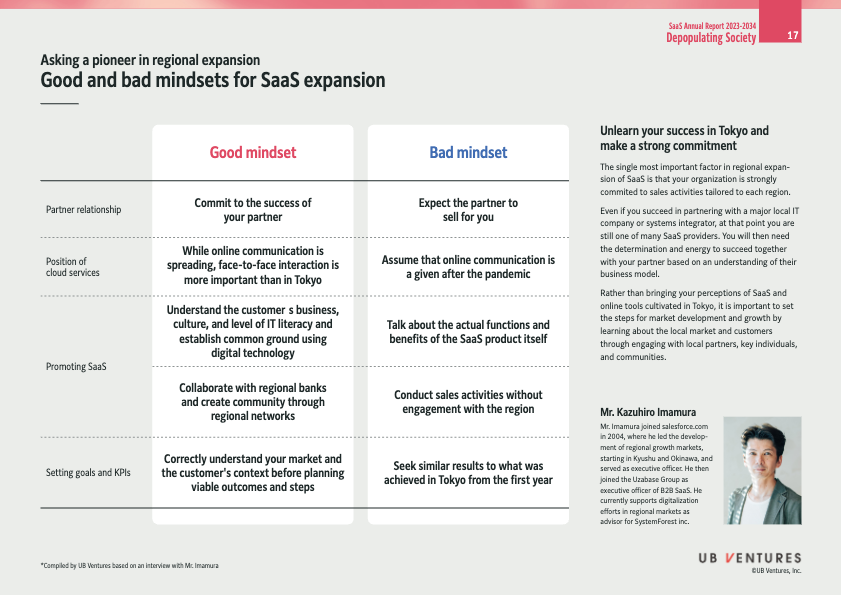
Overview
This document provides insights from Mr. Kazuhiro Imamura on effective strategies for SaaS expansion in regional markets. It emphasizes the importance of adapting approaches used in Tokyo to fit local contexts and highlights mindsets that contribute to successful regional expansion.
Good vs. Bad Mindsets
| Aspect | Good Mindset | Bad Mindset |
|---|---|---|
| Partner Relationship | Commit to the success of your partner. This creates mutual benefits and long-term relationships. | Expect the partner to sell for you, which can lead to disengagement and lack of trust. |
| Position of Cloud Services | While online communication is spreading, prioritize face-to-face interaction, especially outside major cities like Tokyo. | Assume that online communication is sufficient post-pandemic, possibly neglecting personal connections. |
| Promoting SaaS | Understand the customer’s business, culture, and IT literacy. Establish common ground using digital technology to ensure relevance. | Focus solely on the product’s functions and benefits without considering the user’s context. |
| Community Collaboration | Collaborate with regional banks and create community through regional networks to build trust and credibility. | Conduct sales without regional engagement can lead to missed opportunities and connections. |
| Setting Goals and KPIs | Correctly understand your market and customer context before planning viable outcomes and steps to ensure realistic expectations. | Seek results similar to Tokyo’s immediately, potentially ignoring differing market dynamics. |
Key Insights
- Localized Commitment: Customize sales activities for each region. A one-size-fits-all approach can ignore unique local market dynamics.
- Partner Synergy: Collaborate deeply with partners, learning about their business models to enhance mutual growth.
- Beyond Tokyo’s Success: Use experiences from Tokyo as a foundation, but adapt strategies by engaging with local communities and understanding regional needs.
About Mr. Kazuhiro Imamura
Mr. Imamura has extensive experience in developing regional growth markets. He began his career at Salesforce.com, later moving to the Uzabase Group, and currently advises SystemForest Inc. His work focuses on supporting digital transformation in regional markets.
Conclusion
For successful SaaS expansion, it is crucial to adopt a mindset that prioritizes local engagement and understanding. By building strong partnerships and customizing approaches, businesses can achieve sustainable growth in regional markets.
Extended readings:
24 Startups Tackling the Challenges of a Depopulating Society
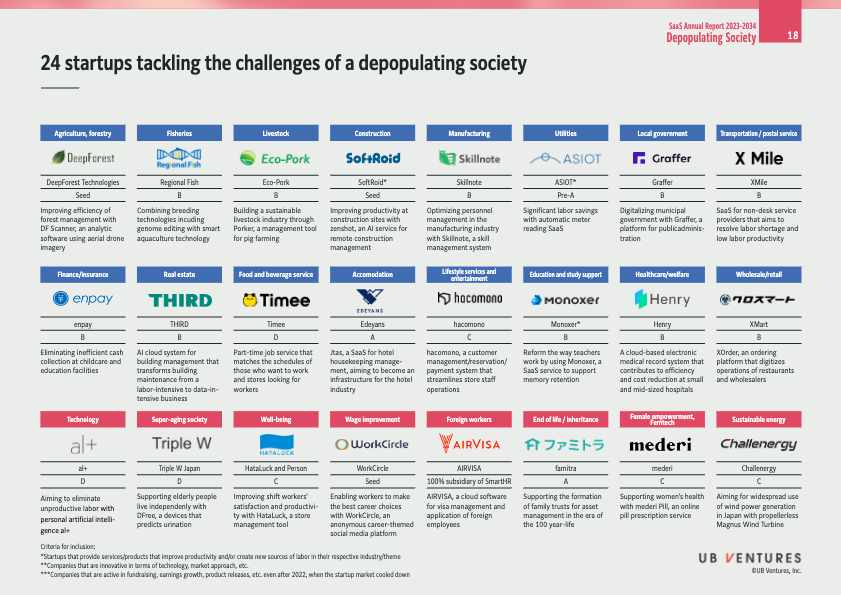
Agriculture, Forestry
- DeepForest Technologies: Focuses on improving forest management efficiency using DF Scanner, an analytic software with aerial drone imagery.
- Insight: Effective forestry management could help in sustainable resource use and environmental conservation.
Fisheries
- Regional Fish: Uses breeding technologies, including genome editing, combined with smart aquaculture.
- Insight: Advanced breeding techniques can enhance fish yield and sustainability in fisheries.
Livestock
- Eco-Pork: Aims to build a sustainable livestock industry through 'Porker', a management tool for pig farming.
- Insight: Streamlined livestock management could enhance productivity and sustainability in animal husbandry.
Construction
- SoftRoid: Offers AI-based services for remote construction management to boost productivity.
- Insight: Automation in construction can address labor shortages and enhance project efficiency.
Manufacturing
- Skillnote: Provides skill management systems to optimize personnel management in manufacturing.
- Insight: Effective workforce management is crucial in maintaining productivity in manufacturing sectors.
Utilities
- ASIOT: Develops solutions for significant labor savings with automatic meter reading SaaS.
- Insight: Automation in utilities management can lead to cost savings and efficiency improvements.
Local Government
- Graffer: Digitalizes municipal government operations to streamline public administration.
- Insight: Digitization in government can improve service delivery and citizen engagement.
Transportation / Postal Service
- XMile: Aims to enhance non-desk service provider operations to combat labor shortages.
- Insight: Efficiency in transportation services can improve overall logistics and supply chain effectiveness.
Finance / Insurance
- enpay: Eliminates inefficient cash collection in childcare and education facilities.
- Insight: Efficient financial transactions can support administrative operations in various sectors.
Real Estate
- THIRD: Offers AI cloud solutions transforming building management from labor-intensive to data-intensive processes.
- Insight: Data-driven management in real estate can optimize operations and maintenance.
Food and Beverage Service
- Timee: Provides part-time job services matching workers with store schedules.
- Insight: Flexible employment solutions can benefit both workers seeking part-time roles and businesses needing staff.
Accommodation
- Edeyans: A SaaS solution for hotel housekeeping management aiming to become industry infrastructure.
- Insight: Efficient management solutions are key in hospitality to maintain service standards.
Lifestyle Services and Entertainment
- hacomono: Provides a customer management system streamlining store operations.
- Insight: Integrated management systems can enhance customer service experiences.
Education and Study Support
- Monoxer: Reforms educational methods by supporting memory retention through SaaS.
- Insight: Innovative educational tools can improve learning outcomes and teacher efficiency.
Healthcare / Welfare
- Henry: Cloud-based electronic medical records system for small and mid-sized hospitals.
- Insight: Digitized healthcare records can enhance patient care and reduce operational costs.
Wholesale / Retail
- XMart: Develops a platform for digitizing restaurant and wholesaler operations.
- Insight: Digital transaction platforms can streamline vendor operations and improve service delivery.
Technology
- al+ : Targets eliminating unproductive labor through personal AI.
- Insight: AI in technology can significantly alter labor dynamics and enhance productivity.
Super-Aging Society
- Triple W Japan: Supports elderly living autonomy with predictive urination devices.
- Insight: Health tech innovations can improve the quality of life for aging populations.
Well-being
- HataLuck and Person: Boosts worker satisfaction and productivity using management tools.
- Insight: Tools that enhance workplace satisfaction can lead to improved performance and retention.
Wage Improvement
- WorkCircle: Empowers workers in making career decisions via a social media platform.
- Insight: Career guidance platforms can support informed career growth decisions for workers.
Foreign Workers
- AIRVISA: Cloud software for managing visas and applications for foreign employees.
- Insight: Efficient management of foreign workers can ease integration and compliance processes.
End of Life / Inheritance
- famitra: Supports family trust formation for asset management in a long-lived society.
- Insight: Planning tools can assist in effective wealth transfer in aging demographics.
Female Empowerment, Femtech
- mederi: Offers an online pill prescription service supporting women’s health.
- Insight: Femtech solutions enhance women's health management and access to care.
Sustainable Energy
- Challenergy: Develops wind turbines aiming for extensive adoption of wind power in Japan.
- Insight: Sustainable energy solutions are crucial in transitioning to a greener future.
Extended readings:
Issues and Solutions in the Construction Industry
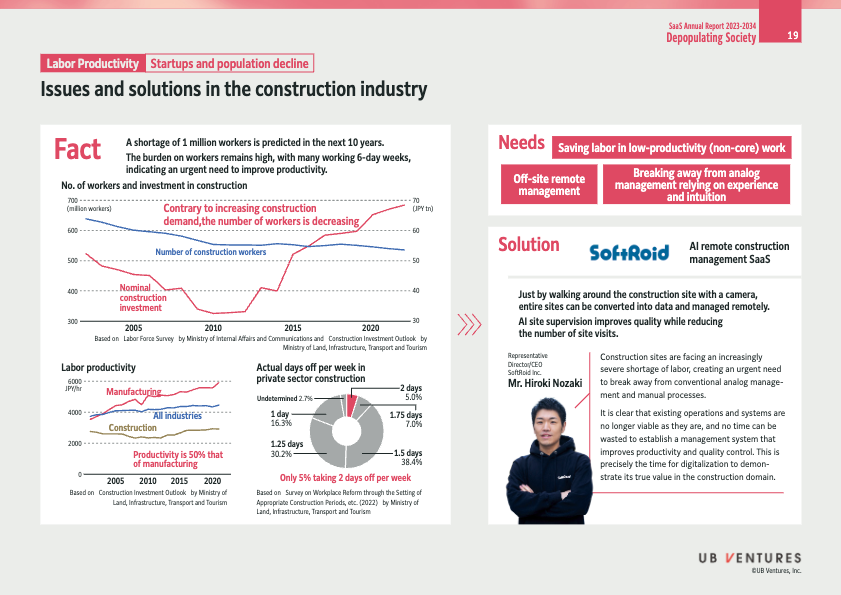
Fact
-
Worker Shortage Prediction
- A shortage of 1 million workers is anticipated over the next 10 years.
- Explanation: The construction industry faces a declining workforce against a backdrop of high demand, increasing the burden on existing workers.
-
Labor Burden
- Most workers endure 6-day work weeks, highlighting severe productivity issues.
- Insight: This high workweek norm indicates a need for better work-life balance and efficiency improvements.
Key Data
Number of Workers and Investment in Construction
- Trends (2005-2020)
- While construction demand increases, the number of workers decreases.
- Nominal construction investment has fluctuated but generally increased.
Labor Productivity
- Comparison with Manufacturing
- Productivity in construction is only 50% of that in manufacturing.
- Idea: Strategies to boost productivity should borrow from manufacturing efficiencies.
Actual Days Off Per Week in Private Sector Construction
- Statistics
- 38.4% of workers take 1.5 days off per week.
- Only 5% of workers take 2 full days off weekly.
Days Off Percentage 2 Days 5.0% 1.75 Days 7.0% 1.5 Days 38.4% 1.25 Days 30.2% 1 Day 16.3% Undetermined 2.7%
Needs
- Efficiency Improvements
- Save labor in non-core low-productivity tasks.
- Implement off-site remote management.
- Transition from analog management based on experience and intuition.
Solution: SoftRoid
-
AI Remote Construction Management SaaS
- Method: Capturing site data with a camera for remote management.
- Result: AI supervision enhances quality and reduces site visit frequency.
- Significance: Digital transformation is critical to addressing labor shortages by optimizing operations.
-
Leadership
- Representative: Mr. Hiroki Nozaki, Director/CEO of SoftRoid Inc.
Insight: This approach underscores the shift towards digital solutions to meet the growing demands and constraints of modern construction sites.
Issues and Solutions in Employment of Foreign Workers
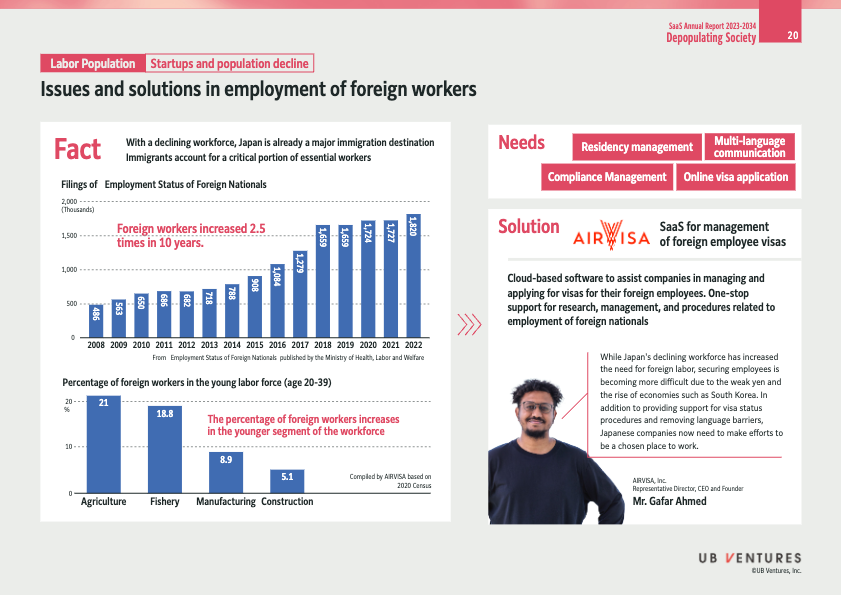
Overview
Japan's declining workforce has increased its reliance on foreign workers. Immigrants play a crucial role in maintaining essential services due to a shrinking native workforce.
Trends and Statistics
-
Increase in Foreign Workers:
- From 2008 to 2022, the number of foreign workers in Japan increased 2.5 times.
- The number of filings for employment status of foreign nationals rose from 486,000 in 2008 to 1,820,000 in 2022.
Year Employment Filings (Thousands) 2008 486 2022 1,820 -
Young Labor Force Participation:
- A significant portion of foreign workers are young (age 20-39).
- The percentage of foreign workers is highest in agriculture (21%) and lowest in construction (5.1%).
Sector Percentage of Young Foreign Workers (%) Agriculture 21.0 Fishery 18.8 Manufacturing 8.9 Construction 5.1
Needs and Challenges
- Key Requirements:
- Residency management
- Multi-language communication
- Compliance management
- Online visa application
- Challenges:
- Declining domestic workforce
- Economic conditions (e.g., weak yen)
- Competing economies (e.g., South Korea)
Solutions
-
AIRVISA: SaaS for Foreign Employee Visa Management:
- A cloud-based platform that assists companies in managing visas for foreign employees.
- Provides comprehensive support for research, management, and compliance related to employing foreign nationals.
- Aims to streamline visa applications and overcome language barriers, making Japan a more attractive place to work.
-
Strategic Adjustments:
- Companies are encouraged to improve work conditions to attract foreign talent.
- Focus on creating a supportive and inclusive work environment for international employees.
Key Insight
While Japan faces demographic challenges, leveraging technology like AIRVISA can help manage and integrate foreign labor effectively. This presents opportunities for innovation in HR practices and increased competitiveness in the global market.
Extended readings:
UB Ventures Overview
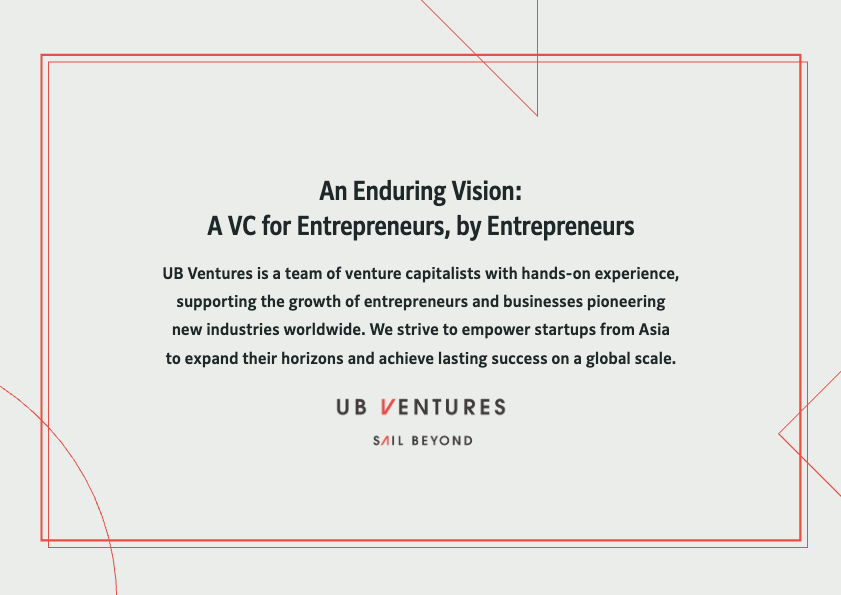
Vision and Mission
- Enduring Vision: UB Ventures aspires to be a venture capital leader by entrepreneurs, for entrepreneurs.
- Insight: This vision highlights a peer-to-peer approach, suggesting they understand the challenges and opportunities entrepreneurs face.
- Additional Information: Venture capital (VC) firms invest in startups and small businesses with perceived long-term growth potential.
Team and Approach
- Hands-on Experience: The team comprises venture capitalists with direct entrepreneurial experience.
- Insight: This can make UB Ventures particularly valuable to startups, as the team is likely to provide mentorship and practical business insights.
- Additional Information: "Hands-on" typically means they are actively involved, beyond just financial investment.
Global Focus
- Supporting Industry Pioneers: Aimed at fostering growth for businesses that are innovating across global markets.
- Insight: Their focus might be on sectors that are ripe for innovation and disruption, which can provide high returns but also entail high risk.
Regional Empowerment
- Asian Startups: Emphasis on empowering Asian startups to achieve global success.
- Insight: This suggests a strong understanding of regional markets and opportunities, and the potential to leverage local innovations on a global stage.
- Additional Information: Asia's growing economy and tech scene provide numerous opportunities for startup growth.
Slogan
- Sail Beyond: This slogan suggests a focus on ambitious, forward-thinking growth and exploration.
- Insight: It implies a commitment to helping businesses navigate beyond their current capabilities and markets.
Brand Identity
- Logo and Design: The branding, including the logo with "UB Ventures" and "Sail Beyond," emphasizes a modern and dynamic approach.
- Insight: Effective branding can attract potential entrepreneurs and partners by conveying professionalism and innovation.
Extended readings:
UB Ventures, Inc. Overview
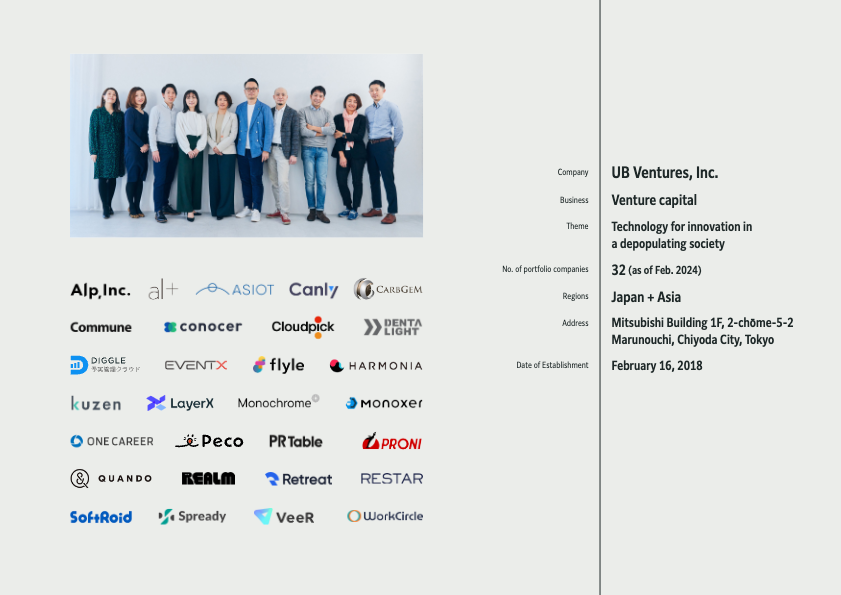
Company Profile
Name: UB Ventures, Inc.
Business: Venture Capital
Theme: Technology for innovation in a depopulating society
Insight: The focus on depopulation suggests investment in solutions that address challenges such as workforce shortages, elder care, and rural revitalization.
Number of Portfolio Companies: 32 (as of February 2024)
Insight: A moderate-sized portfolio allows for focused nurturance of startups, fostering growth through targeted mentorship and investment.
Regions: Japan + Asia
Insight: Focusing on Asia, especially Japan, indicates investments in a region with unique demographic challenges and opportunities for technological advancement.
Address: Mitsubishi Building 1F, 2-chōme-5-2 Marunouchi, Chiyoda City, Tokyo
Insight: The location in Tokyo’s business district reflects a strategic position within a major financial and innovation hub.
Date of Establishment: February 16, 2018
Insight: Being relatively new allows the firm to leverage modern technologies and methodologies in venture capital.
Portfolio Companies
UB Ventures includes a diverse range of companies in its portfolio:
- Alp, Inc.
- alt
- ASIOT
- Canly
- CarbGem
- Commune
- conocer
- Cloudpick
- Denta Light
- DIGGLE
- EVENTX
- flyle
- HARMONIA
- kuzen
- LayerX
- Monochrome®
- monoxer
- ONE CAREER
- Peco
- PR Table
- PRONI
- QUANDO
- REALM
- Retreat
- RESTAR
- SoftRoid
- Spready
- VeeR
- WorkCircle
Insight: These companies span various industries, indicating a diversified investment strategy aiming to mitigate risks associated with sector-specific downturns.
Additional Observations
- Innovation Focus: The emphasis on technology highlights a strong interest in scalable, impactful solutions.
- Regional Specialization: Although the focus is on Japan and Asia, these regions offer unique demographic and market challenges for innovative solutions.
Key Terms:
- Venture Capital: A form of private equity financing provided to startups and small businesses with perceived long-term growth potential.
- Portfolio Companies: Companies in which a venture capital firm has invested. Their progress reflects the success and strategic direction of the venture firm.
Extended readings:
Tackling Japan's Social Issue of Depopulation
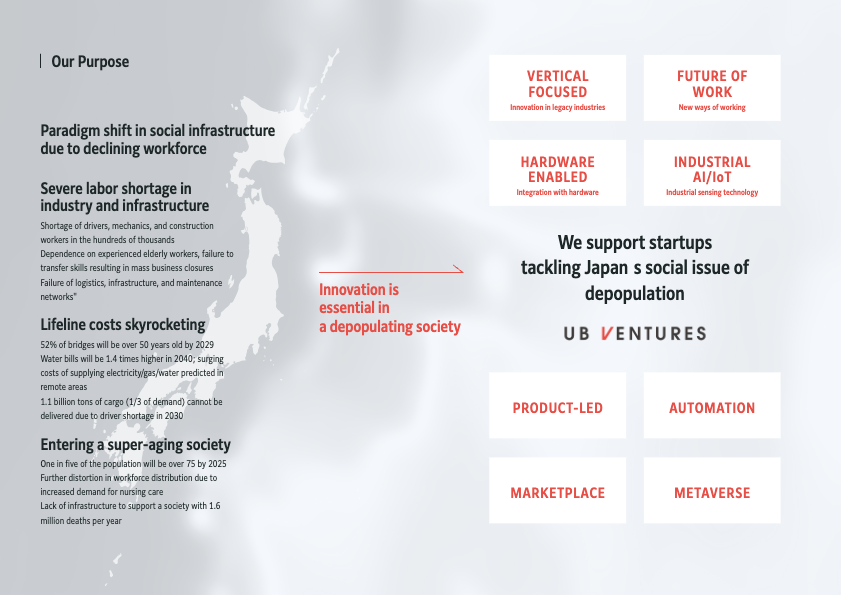
Our Purpose
Paradigm Shift in Social Infrastructure
- Declining Workforce
- Severe labor shortages in key sectors such as drivers, mechanics, and construction.
- Heavy reliance on experienced elderly workers, risking skill gaps and business closures.
- Insight: As the workforce ages, transferring skills effectively is critical to sustaining industries.
Lifeline Costs Skyrocketing
- Aging Infrastructure
- By 2029, 52% of bridges will be over 50 years old.
- Water bills are expected to increase by 1.4 times in 2040.
- Costs for essential services like electricity, gas, and water will rise significantly, challenging remote areas.
- Insight: Investing in infrastructure renewal can mitigate skyrocketing costs and ensure service continuity.
Entering a Super-Aging Society
- Demographic Changes
- By 2025, one in five individuals will be over 75.
- Workforce distribution will skew toward nursing care due to increased demand.
- Infrastructure must evolve to handle 1.6 million deaths annually.
- Insight: Supporting advancements in healthcare and eldercare is vital.
Innovation Areas
-
Vertical Focused
- Innovating within legacy industries to modernize practices.
- Insight: Longstanding industries can benefit from integrating new technologies to remain competitive.
-
Future of Work
- Embracing new work methodologies and environments.
- Insight: Flexible work environments can attract younger talent and improve efficiency.
-
Hardware Enabled
- Integration with cutting-edge hardware technologies.
- Insight: Enhancing productivity and precision through hardware innovations.
-
Industrial AI/IoT
- Leveraging industrial sensing technology to optimize operations.
- Insight: Data-driven approaches can significantly boost operational efficiency.
-
Product-Led
- Focus on creating products that drive growth and innovation.
- Insight: Product innovation is key to maintaining market relevance.
-
Automation
- Utilizing automation to handle routine tasks and mitigate labor shortages.
- Insight: Automation can fill gaps in the workforce and reduce manual errors.
-
Marketplace
- Developing platforms that connect supply and demand efficiently.
- Insight: Digital marketplaces can streamline transactions and expand reach.
-
Metaverse
- Exploring the potential of virtual spaces for collaboration and business.
- Insight: The metaverse offers new avenues for engagement and interaction.
Supporting Startups
- Objective
- UB Ventures is committed to supporting startups that tackle the challenge of depopulation in Japan.
- Insight: Startups are poised to drive innovative solutions that address societal challenges effectively.
Extended readings:
UB Ventures SaaS Annual Report 2023-2024
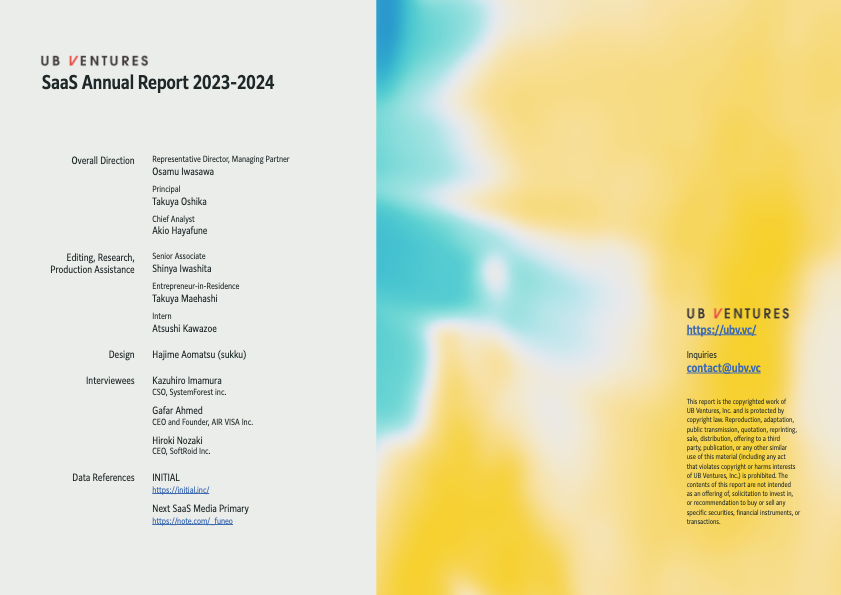
Overview
Direction and Management
-
Overall Direction:
- Representative Director, Managing Partner: Osamu Iwasawa
- Principal: Takuya Oshika
- Chief Analyst: Akio Hayafune
Insight: Leadership plays a crucial role in guiding the direction and strategic decisions of the company. Osamu Iwasawa, as the managing partner, largely influences the vision and goals of UB Ventures.
Team Roles
-
Editing, Research, Production Assistance:
- Senior Associate: Shinya Iwashita
- Entrepreneur-in-Residence: Takuya Maehashi
- Intern: Atsushi Kawazoe
Insight: A diverse team in terms of roles ensures a holistic approach to research and production, allowing for innovative thinking, especially with the inclusion of an Entrepreneur-in-Residence.
Design
-
Designer: Hajime Aomatsu (sukku)
Insight: Design in reports is essential for clarity and engagement, facilitating better understanding through visual aids.
Interviews
-
Kazuhiro Imamura: CSO, SystemForest Inc.
-
Gafar Ahmed: CEO and Founder, AIR VISA Inc.
-
Hiroki Nozaki: CEO, SoftRoid Inc.
Insight: Interviews with industry leaders provide invaluable insights into the SaaS sector and help identify emerging trends and challenges.
Data References
-
INITIAL: https://initial.inc/
-
Next SaaS Media Primary: https://note.com/_funeo
Insight: Access to reliable data sources is vital for accurate analysis and reporting, allowing companies to make informed decisions.
Contact and Inquiries
-
Website: UB Ventures
-
Email: contact@ubv.vc
Insight: Clear communication channels are important for engagement with stakeholders and ensuring transparency.
Copyright Note
-
Protection: The report is copyrighted by UB Ventures, Inc. Any form of reproduction, adaptation, or distribution without permission is prohibited.
Insight: Copyright laws protect the interests of the company and ensure the integrity and originality of their work.
These notes capture the key elements of UB Ventures' SaaS Annual Report, highlighting the organizational structure, collaborative efforts, and compliance measures in place.
Extended readings: